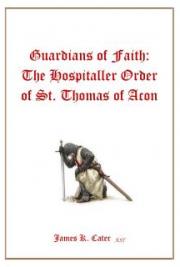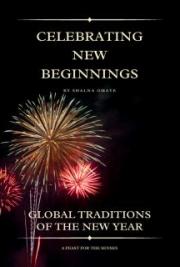
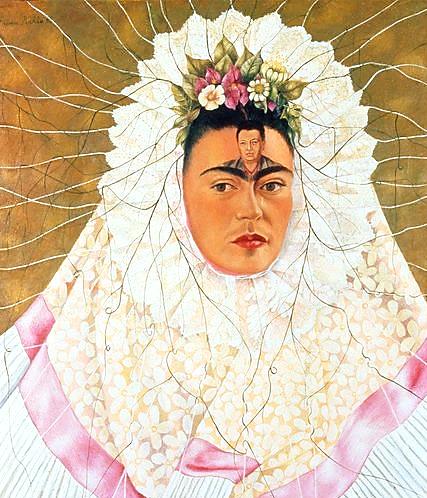
ARTY
STORIES
Book 7
PAST VOICES
Stories behind the Art
Art and life
across the centuries

Ian Matsuda, FCA, BA (Hons)
for
Noko
Copyright
Ian Matsuda, FCA, BA (Hons), 2017
All rights reserved. No part of this publication may be reproduced, stored in retrieval system, transmitted or utilised in any form or by any means, electronic, mechanical, photocopying, recording or otherwise, without written permission from the publisher or licence holder
‘ARTY STORIES’
Art & Life across the centuries
‘Seeing people’s lives brings their art to life’
See the stories that made the art – the times – the place – the people A refreshingly entertaining introduction to art in this series of 7 books that takes you through the art and the lives, both of artists and of people Together they provide a sweeping framework in which to follow and understand the struggles and triumphs through peace and war, from 3,000BC until today. The Egyptian peasant to the New York sophisticate.
Produced in a new and accessible introduction that celebrates the wonderful art and myriad lives over the centuries, bringing art and history together. Step into the artist’s worlds of new societies each producing new art.
Ideal for student and art lover alike – with 250 illustrations
Supported by the Arts Council, England as:
‘creative and engaging for young people’
‘the opportunities to stimulate interest and imagination are evident’.
Centuries of great art are a gift to us all
Books in this Series
Book 1 Egypt - Greece - Rome Empires come & Empires go 2 The Renaissance in Italy Rulers rule, Painters Create
3 The Four Princes War, Terror & Religion 4 Northern Europe Revolution & Evolution 5 The American Dream Depression to Optimism
6 The Modern World The ‘..isms’ of Art
7 Past Voices Stories behind the Art All free e-book downloads
https://www.artystories.org
Book 7
PAST VOICES
Stories behind the art
CONTENTS
• Frida Kahlo ‘Diego on my mind’
• Cecilia Gallerani ‘Lady with an Ermine’
• Ruby Bridges ‘The problem we all live with’
• Dora Marr ‘The Weeping Woman’
• Kenji Miyazawa ‘Night on the Galactic Railroad’
• Nefertiti ‘The bust of Nefertiti’
• Sources of information

FRIDA KAHLO 1907-1954
‘
‘Diego on my mind’
Self-portrait, 1943 Natasha Gelman Collection

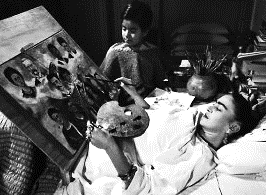
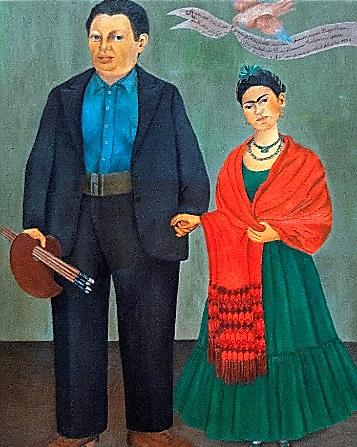
My Diary
September 1923
Oh joy, back to school and meet up with my lovely Arias and talk of socialist revolution! My parents think he is too extreme and have forbidden me to see him – tricky! But we will write and soon be back together.
September 17, 1925
Horrors! Such pain, the bus home crashed and I have been pierced ‘the way a sword pierces a bull’! The agony when my friends pulled the guard rail out of my pelvis! The doctors aren’t sure if I will ever walk again! So many drugs, I am having hallucinations of skeletons. All from changing buses with Arias.
December, 20, 1925
So many bones broken, my body has been wrecked. But at last I am home -
confined to bed, but I can still paint with an easel propped up. I am even using a mirror to paint a self-portrait. I have taken my first steps!
June, 1928 I must know if I am good enough to earn my living as an artist so I took my work to the famous artist Diego Rivera. He said that they had ‘an unusual energy of expression, personality and that I was an authentic artist’ – Wow! He has even painted me holding ammunition in his giant mural of the
Mexican Revolution. 124 frescoes! (1) I am immortalised!
August, 21, 1929
Yee! - against my mother’s wishes, we are married. But she
worries that he is 20 years older and it is ‘a marriage
between an elephant and a dove’! But I feel ‘we are born for
each other’. Even if he has short lived affairs, we are bound by
‘loyalty not fidelity’. It’s all power and intensity.
‘The Arsenal’, 1928 Our wedding, Frida Kahlo, San Francisco, 1931

November, 1931
Our trip to New York has been a great success and I am to share a show with Diego. But each of our affairs cast a shadow between us. My pain only increases and now I have lost our baby. I despise the capitalism of America.
April, 1932 We have moved to the hard city of Detroit and I find my suffering in body and in mind has led me to
produce religious paintings. I am so depressed.
Oh Diego, there have been ‘two accidents in my life,
the bus and you – you are by far the worst!’
Diego has again drawn praise and criticism in
equal measure with his 27 giant frescoes. He thrives
on deliberately stirring emotions - including mine!
But I share the excitement and inspiration in my
own work. We must go back home to Mexico, where I
have always dreamed of having my own show.
‘Detroit Industry’, 1932-33
January, 1935
My body has been assaulted with abortions, appendicitis and now the amputation of two toes. I feel weak and now Diego has even seduced my younger sister! I am moving out. We must surely part for both our sakes. But?
January, 1937
Now we are thrust into the political limelight as Leon Trotsky and his wife flee Stalin and come to live with us.
What conversations over dinner to hear how communism has been hijacked by Stalin. Leon feels that his Russia is lost and is now a police state. He is a very engaging and vibrant man. I feel very drawn to him – infidelity?!
November, 1939
Diego and I are divorced. I missed him so when we were apart. We are both worn down by our infidelities. Now my art opens up to absorb me. My pain can be shown in these works – a pain that the whole world is now feeling.

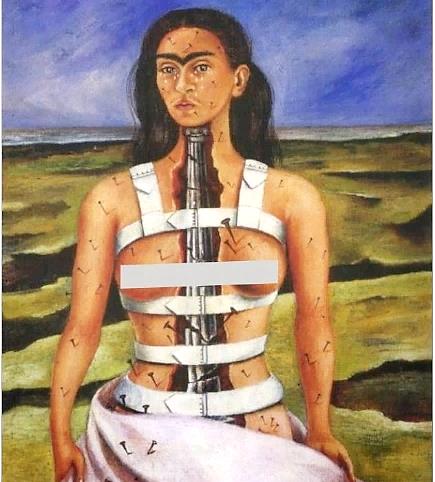
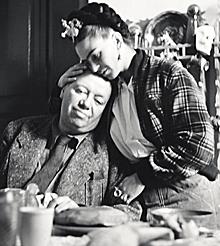
September, 1940
My paintings have a new life, portraying myself in my endless suffering. Diego is ever-present ‘on my mind’. (depicted in the opening picture of the wedding dress)
He visits every day and encourages all my work, lifting me to new heights.
December, 8, 1940
We are together again. He says he ‘misses us’. We feel so much for each other, despite all the torments we have made. But we must live apart if we are to live together. My supportive corsets are giving less and less relief on my spine and it’s so hard to stand at my easel. I feel my body collapsing each day.
November, 1950 I seem to have been in this hospital for ever, but the new bone graft to my spine seems to have finally helped. Spending time in my wheelchair has let me dedicate myself to the communist cause. People now listen to me -my suffering seems now to have a purpose. I pray for peace in the world.
May, 1953
My own exhibition, here in Mexico! No doctor will keep
me from going! I sent my bed on ahead and they carried
me in! Such joy, such pride, such sadness, such pain.
‘The Broken Column’, Frida Kahlo, 1944
February, 1954
My life has now lost its purpose – I feel lost – ‘they have amputated my leg and given me centuries of torture’. I have tried to end it all, but it is the thought of ‘Diego that keeps me, through my vain idea that he would miss me. I have never suffered more’. ‘I joyfully await the exit – and I hope I never return’.
Frida died in July, 1954, but her works would go on to be declared part of the Mexico’s cultural heritage and tour the world. (2) The Tate Modern considers her ‘one of the most significant artists of the 20th century’. Diego is now considered the greatest Mexican artist of the 20th century, credited with the reintroduction of fresco painting in modern art. Diego died in 1957, 3 years after Frida.
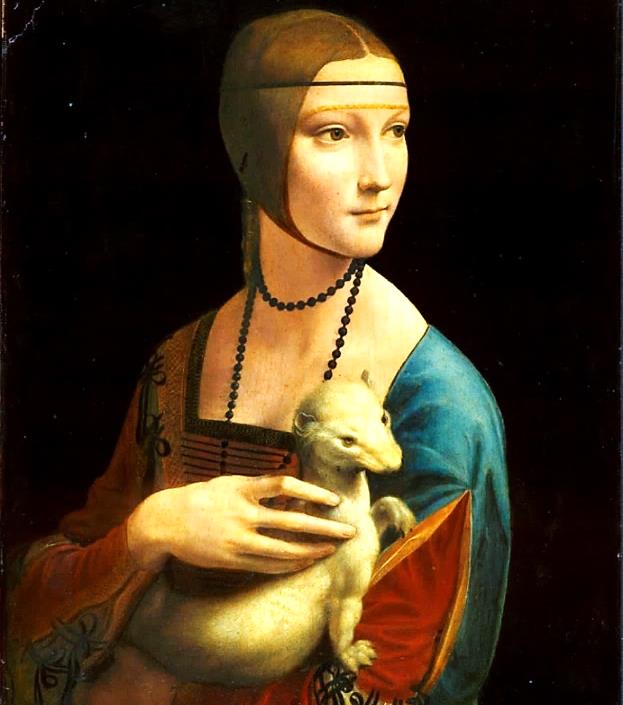
CECILIA GALLERANI c.1473-1536
‘Lady with an Ermine’
Leonardo da Vinci, 1489-90, National Museum of Poland

My diary
1486, my 13th Birthday
Great changes – having studied with my brothers, the time has come for me to move and live with women –
actually nuns! It has been decided that I should continue my studies in the Monastero Nuovo, which has a great library where I can read poetry with tutors who can speak Latin with me.
It will be hard to leave my family, but it is for my future and I have high hopes!
1489, my 17th year
The grand Duke of Milan, Ludovico Sforza, came to the monastery to hear my poetry. Apparently, he had heard of me through the young Ippolito d’Este who shares my interest. His father; the Duke of Ferrara; is a great patron of the arts. He is a friend of this Duke of Milan who is betrothed to his daughter and Ippolito’s sister, Beatrice. All between families!
The Duke of Milan – Ludovico - is very handsome and seemed to take an interest in me and we enjoyed sharing our interests. Perhaps this is the future I have waited for. I have high hopes!
He has commissioned the great artist Leonardo da Vinci to paint my portrait.
He has suggested including an Ermine, celebrating Ludovico’s prestigious appointment to the Order of the Ermine., by the King of Naples last year. (Book 3) Cecilia, ‘La belle Ferronniere’, Leonardo da Vinci, 1490-1495, Louvre, Paris 1489
The Duke has taken me to live in his castle and join all the wonderful balls and receptions. It is a very grand society from all over Europe! The Duke has become the love that I had always wished and hoped for.
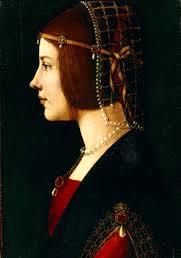
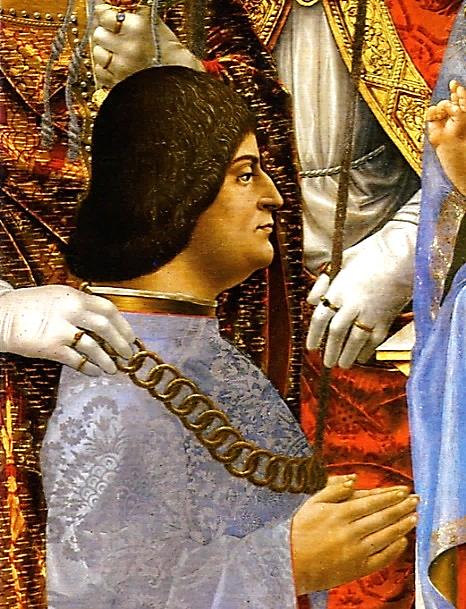
1490
The betrothal to Beatrice has fallen due, but the Duke is very confused, as Beatrice is very immature and poorly educated - indulging her time in dancing and parties. But he is committed.
But Ludovico is so happy that I am with child and has heaped great privileges on my brothers. My life today is wonderful.
17, January 1491
Ludovico has finally married Beatrice and I fear that I will have to leave the castle.
Ludovico has promised a house and land in Pavia, but first I am to have my child here.
3, May 1491
I have a wonderful boy Cesare Sforza and his father – Ludovico -has even given me the town of Saronno!
‘Portrait of a Woman’ c.1490-92, Leonardo da Vinci, Beatrice d’Este, aged possibly just 15-17
27 July, 1492
My life here has been full of wonder and we are both so proud of our son Cesare –
although he’s now a little chubby!
But, Oh dear, great change! Beatrice has become so upset that Ludovico should give us both the same dress that now I need to step out of Ludovico’s life! I am to be married to Count Carminati di Brambilla, but Ludovico has lavished a great dowry for me and our son Cesare is to have a palace in Milan in his own right.
I am sad yet happy.
‘Ludovico Maria Sforza’, Unknown Master, 1494-1495, Palazzo Sforzesca, Milan
29 April, 1498
The Count and I have a wonderful family life with our own children and now - as a woman of fortune and society - the time has come for me to put my younger days behind me. Beatrice has sadly died in childbirth, causing great loss to Ludovico who had come to love her. That great patron of the arts; Isabella d’Este; is looking for an artist to paint her portrait and has asked to see Leonardo’s portrait of me when I was just 17 -
‘The Ermine’. It is so unlike me today. A different world that I have left behind. From mistress to Countess!
May, 1498
Oh dear, Isabella has decided not to commission Leonardo as his work is too revealing and lifelike! I now have no interest as to what happens to the painting. I’ll leave it to ‘fate’.
27, May,1508
I have just heard that Ludovico has died in very poor circumstances, having been thrown into a dungeon by the French King, who had defeated him in the battle for Milan. The great man and Cesare’s father, is no more.
Cecilia’s father was not born into nobility, but held several posts at the Milanese court, although he died when she was just seven.
Unusually for the time, she was educated in Latin alongside her six brothers and grew into a lively conversationalist, accomplished musician, singer and poet. These qualities would have been appreciated by the cultured Duke of Milan. Although he had several mistresses, he always had the courtesy to have one at a time and was believed to have been faithful to Cecilia during their three years together, officially recognising their son. Having been defeated by Louis XII of France, he spent 8 years in comfortable captivity, but was thrown into the dungeon when he tried to escape.
Cecilia had a long and happy marriage with Count Carminati (known as ‘Il Bergamino’, a popular liqueur!) for 23 years. Her son Cesare was appointed to abbot and latterly Canon of Milan, although dying young at just 21. Cecilia retired to her castle near Cremona, 75km from Milan and lived to be 63. She was universally admired for her patronage of the arts, establishing the first salon in Europe to display works of art. (3)
The later history of ‘Lady with an Ermine’ is unclear until it was acquired by a Polish Prince in 1489. It was rescued in 1830 from the invading Russian Army and moved to Paris to then escape the German occupation of Paris in 1871. During WW1 the painting was moved from Poland to Dresden for safekeeping and later seized by the Nazis in 1940. Subsequently it was recovered by the allied armies and returned to Poland in 1946.
If only Cecilia had known the journey that her portrait would take when she left it to ‘fate’. A forgotten story.
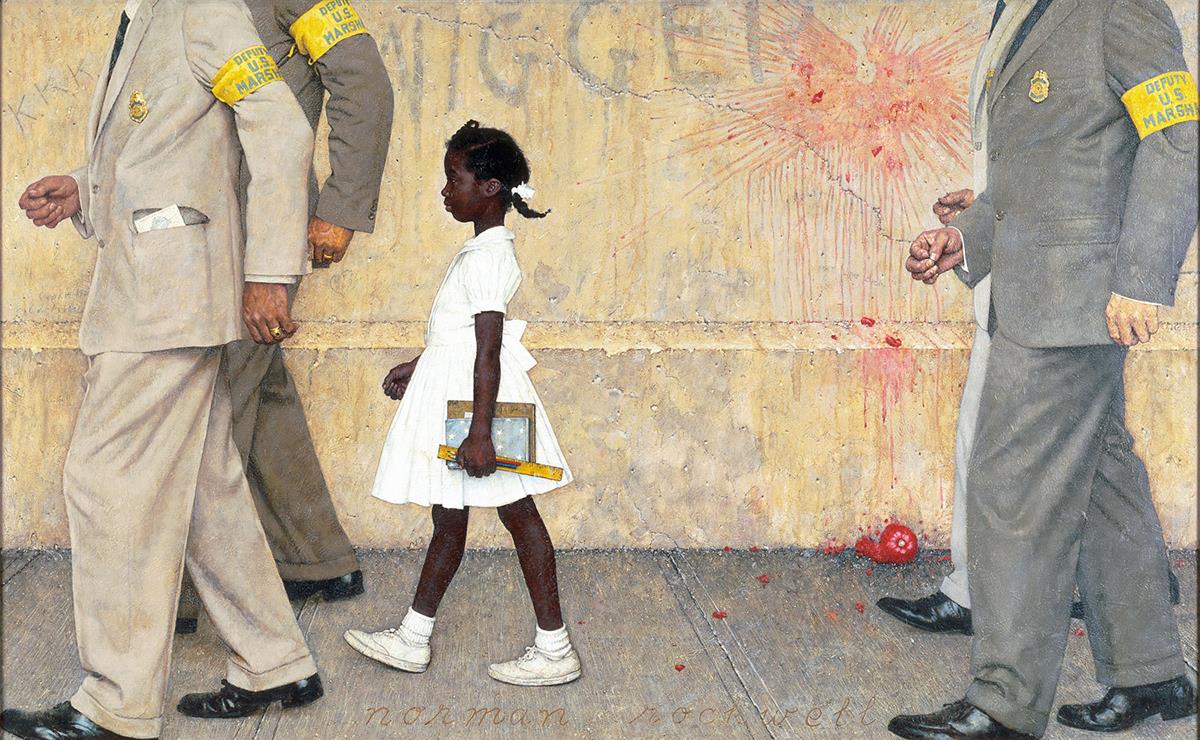
RUBY BRIDGES, born 1954
‘The Problem We All Live With’
Norman Rockwell, 1964, Private Collection



My diary
March 1960
I have just passed my test and can go to the ‘big’ school! Five other children have also passed, so I’ll have friends 4, November, 1960
Today was my first day at my new school and it was very strange. Mother gave me a lovely new white dress and we were taken to the school in a big car by four big white men. Mother said they were like policemen. They said the President had sent them and they told me to ‘walk straight and don’t look back’!
It was like a Mardi Gras with lots of people waving and shouting and throwing things, like tomatoes – very strange. And then we spent the day in the Principal’s office without any classes and we came home.
5, November, 1960
The tall men – came again today to take me to school and I met my teacher Miss Henry in our very own classroom. She is very nice and has come all the way from Boston. I wish there were other children in the class.
My friends haven’t come to this school and a lot of the other children and teachers seem to have left. The people outside were still shouting and singing.
They had a little black doll in a coffin! They don’t seem to like my being here.
Miss Henry and I had a nice lunch together in class, which saved going to the café.

May, 1961
After a long 6 months Miss Henry has at last brought some other white children into a few classes and they are really nice. I was starting to feel lonely, but I still had no-one to play with at break. Miss Henry makes the lesson really fun and I am learning so much. We don’t miss a day, but then neither do the people outside. They must get tired soon – coming and shouting each day.
Summer, 1961
My father has lost his his job at the gas station, but one of our neighbours has given him a new one. Then grandpa and grandma have been turned off their land. It is very sad – we can’t even shop at the grocery store and father has had to leave us. Mother says it is for his new job, but he isn’t very far away and she is very sad.
Dr Coles still comes to the house to help and I think his cousin may have helped with those lovely dresses that I can wear to school.
September, 1961
Oh, I am so pleased as I am at last joining the other classes and no-one is shouting anymore so the big men don’t come to take me to school. One of them said that ‘I showed a lot of courage and never cried. That I just marched along like a little soldier and they were all very proud of me’. Can you imagine!
Much later in my life
I graduated from High School, married had a family and
worked as a travel agent. Then I was really lucky to set up the
Ruby Bridges Foundation to help people from different
backgrounds live a better life together. I have the experience!
I think the lesson I have learned in my life is that you can’t
judge people from the colour of their skin. You have to give
yourself time to get to know them, no matter what they look like.
If I am to make a difference, I really had to explain that to kids.
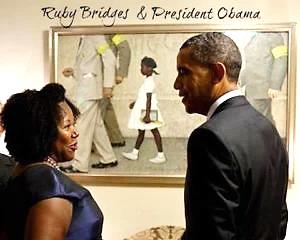
The 50th anniversary
In January 1964 Norman Rockwell painted my first day at school
and then in 2011 President Barack Obama had it hung in the White
House, where I met him and Norman Rockwell. The President told us that ‘If it hadn’t been for you guys, I might not be here and we
wouldn’t be looking at this painting together’. (Book 5)
This was the highlight of my life when Barack Obama opened his
arms and hugged me in front of that picture.
July 15, 2011 The White House, with Barack Obama
Desegregation in schools was resisted in the southern states of America, to the extent that even the presidential candidate George Wallace, blocked the doors at one university. The entrance ‘test’ that Roby Bridges passed, was designed to exclude black children from white schools, limiting their education and prospects in life. It took six years after segregation for the Supreme Court to declare this unconstitutional. Only then did white schools start to offer places to black children and then only on a very restricted basis.
Her parents’ determination to ‘take this step forward …. for all African-American children’, cost them dear with her mother and father separating in the face of real hostility within their community. It was only with the help of equally brave white neighbours, that these changes would succeed and it wasn’t until 2015 that the last school was ordered to de-segregate and all pupils were allowed to travel on the same school bus. (4) Ruby’s story took 55 years to be realised.

DORA MARR 1907-1997
‘The Weeping Woman’, Pablo Picasso, 1937
Tate Modern, London
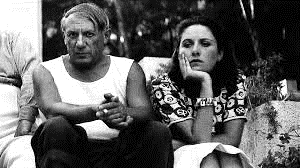

My diary
Spring, 1935
How wonderful it is to be back in Paris. Barcelona and London were really enjoyable, but I love being in my new workshop, courtesy of my father. Paris is alive with ideas and I have joined so many surrealist groups where we try to help the poor. Fascism is having such a dreadful impact on the peoples of Spain, with their government under attack. Such a tragedy.
Summer, 1935
My photography has attracted invitations to produce promotional
photos for film makers. They are very enthusiastic with my surrealist approach. Since art school, I have always loved how surrealism speaks of the confusion in this world, exploring our unconscious mind. I feel so creative.
All so exciting and I am being invited to more exhibitions in Paris and in London. Untitled, Dora Marr, 1934
December, 1935
Tonight, I met the artist Pablo Picasso in the Café des Deux Magots. I was playing ‘Stab between the Fingers’
and had cut myself! He asked for my black gloves -I wonder if it could be as a keepsake. He is very intense and I must admit I was very drawn to him, but he is known for his affairs. But I do wonder!
Spring, 1936
Pablo is keen that I should concentrate on painting, rather than
photography, but he is obsessed with his cubism. I find that difficult to express and he can be very critical.
Life with Pablo is a series of ups and downs – ecstasy to despair – and his wife Olga and son are still very much in his life. It is all so demanding, but I now can’t seem to live without him. I am so confused.
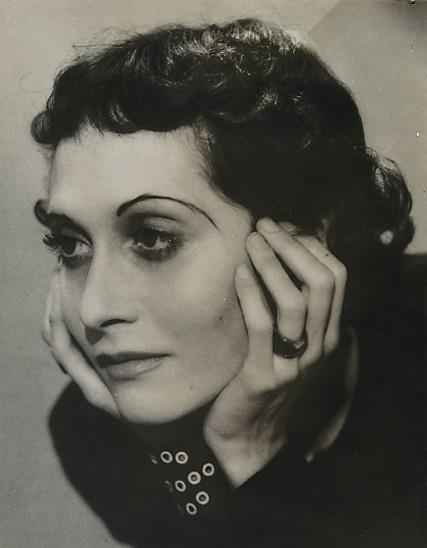
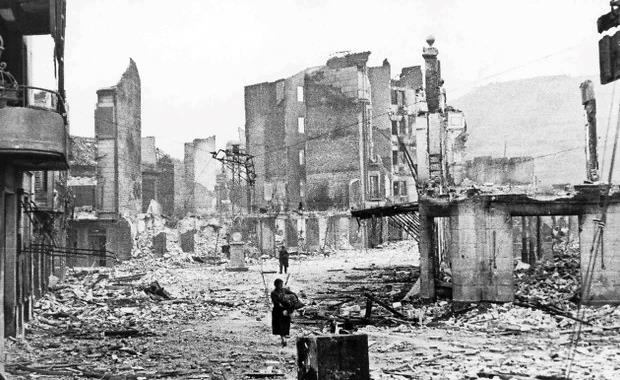
Summer,1936
Our arguments seem to grow fiercer and I find myself very jealous of his seemingly constant affairs. But then he tells me that I am his one true love! He even says that for him my despair ‘has always been the woman who cries’ and that I am ‘the embodiment of sorrow’. But now I am ashamed to confess that he beats me, yet I don’t have the strength to leave. Was I born for sorrow?
Winter,1936
Fascism is now tearing Spain apart and I can feel that Pablo despairs for his homeland. I care for his sorrow, but now there is a seventeen-year-old girl with us. He met her outside of a café and he seems determined to play us off against each other.
He is 55 for god’s sake! His passion for us both is so intense. It is all so cruel.
April 26,1937
Our world has exploded. There has been a terrible bombing
in Spain, in a town called Guernica. Franco has plotted
with Hitler and Mussolini to use their planes to squash the
people. Pablo is full of anger and desperate to help.
May,1937
We hear more of the bombing designed to generate terror
and drive the Republican army to surrender as they see the
death and destruction that can be inflicted by Franco. We
hear that the people had fled the town only to be forced
back by machine guns to bear the full force of the bombing.
In just 3 hours the town was destroyed, with 1,000 killed.
May,1937
Pablo is inspired to create a vast painting to show the world this terrible act. He has set up his canvas in our workshop here. I am helping by photographing each stage of his work so that he can see its progression.
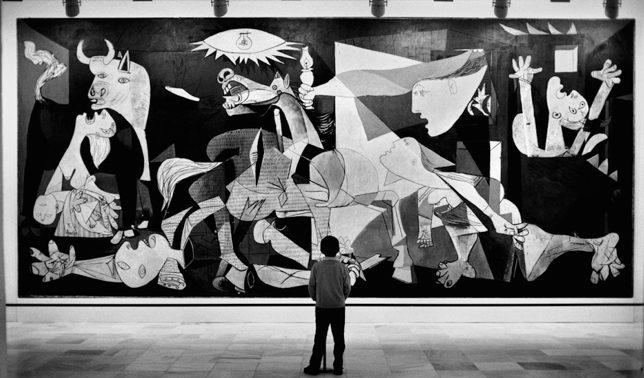

June,1937
The work is complete and I stand in awe at Pablo’s
creation. The canvas is full of suffering which Pablo
seems to have taken on himself. He says that he has
portrayed me centrally - holding the lamp to bring light
on to these terrible events.
The black and white canvas seems to depict even greater
pain and loss. Surely it will be recognised as a powerful
anti-war work, driving the message of peace. (Book 6)
‘Guernica’, Pablo Picasso, 1937, Museo Reina Sofia,
Madrid
October,1937
Now Picasso is charged with expressing my sorrow as a continuation of his theme. I am lost between his art and his cruelty as he explains - ‘Dora for me was always a
‘Weeping Woman’ . (see opening painting) He feels that ‘women are suffering machines’, seeing it as a universal expression of suffering. For me it expresses my own suffering.
Now, in all of his works, he has descended into a world of pain and I find myself consumed by this sadness. I wonder as to what lies ahead and am ashamed if I cannot break this bond of passion, deceit and cruelty. Help!
‘Portrait of Dora Marr’, Pablo Picasso, 1937. Tate Modern, London
Dora Marr finally broke from Picasso in 1943, living in the house that he bought for her – a broken woman. Suffering from a depression that led to a nervous breakdown, she endured electric shock therapy that was illegal at the time. Recovering, she took up painting again – and in the abstract cubist style developed by Picasso. She became a recluse for 50 years, developing brooding landscapes, which may suggest that the ghosts of her past still haunted her. Dora died in July, 1997, still bitterly resenting the role that Picasso had reduced her to, saying: ‘He is an instrument of death, not a man but a disease’. (5) Now her story is known.

KENJI MIYAZAWA 1896-1933
Author of Children’s Books in Japan
‘Night on the Galactic Railroad’, 1927
Adapted to an Anime film in 1985

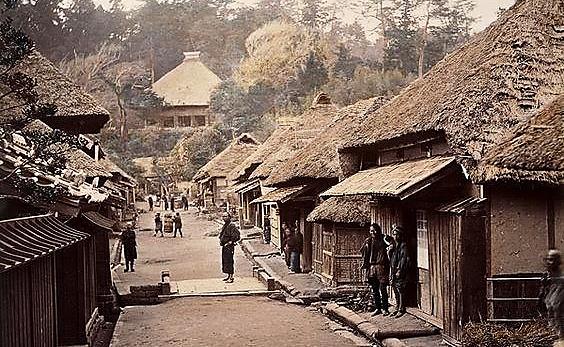
My diary
October,1914
I’m so upset working in my father’s pawnshop. So many
families come in with clothes and furniture – all that
they have and so desperate for money to buy food. The
crops always seem to fail in the many cold spells here in
the North of Japan. It seems so wrong that our family
should be so rich and others so poor. So cruel. (6)
September, 1915 Village, c.1875
So lucky to be given a top scholarship as a special
research student at Agricultural University. At last, I
shall learn to understand nature and how perhaps natural fertilisers can help our farmers here.
March, 1918
I have read the Lotus Sutra describing how our spiritual and material lives are intertwined and how our lives are timeless in a vast universe. We should all live with this holistic understanding. It seems so much more than my father’s Buddhism which just concerns the way we live today. I will change and live my life as part of all life, animal and nature. My father is very upset at my conversion to this Hokke sect.
May, 1920 Graduation! I can go home! My head is so full of ideas to help the farmers grow rice. I am finding it harder ‘eating the bodies of living things’, as ‘like us they want to avoid death and pain.’ I now eat only vegetables from the land. Perhaps I’ll write a story of hunters becoming the hunted in a restaurant where they will be on the menu!
January, 1921
My father’s life is not for me and I have given my share of our wealth to my brother who will use it well. I feel that ‘the world could be burning’ and people need to be rescued from their lives of pain and shown a better way. I will go to Tokyo and share my beliefs with people on the streets. What does life hold for us all?

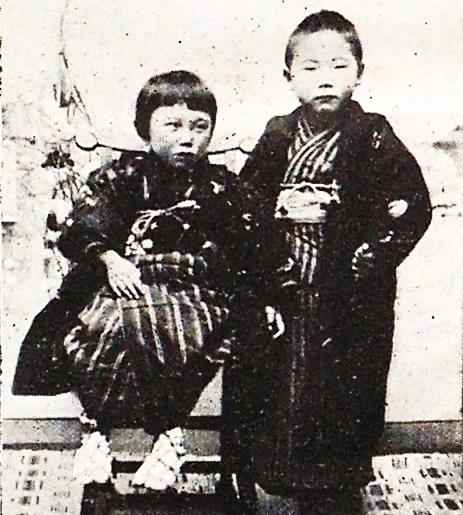
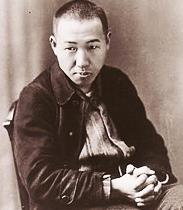
May, 1921
My life on the streets of Tokyo was too hard. My sister Toshi has fallen ill and I have come home to serve as a teacher at our Agricultural school.
At least I shall now have time to write my poetry and children’s stories.
I have sold one for the princely sum of 5 yen! Through these I can perhaps show children their choices in life and how things can change!
Teaching at Agricultural College
27, November, 1922
My sister Toshi has died and I feel that my world has died. She has been part of my life since we were very small. I am so lost. ‘It seems that to reach the truest happiness, one must make their way through many sorrows’. Today I have written three poems to try and tell how I feel. I will call them ‘Voiceless Lament’ as I cannot speak. ‘O my little sister, who will travel far on this day’.
Kenji & Toshi as children
September, 1923
I can now teach at the senior high school, although I am not sure how my students will like my ways. We will spend time outdoors and listen to classical music. I want them to explore ideas of life and see themselves as part of the life all around us. They may think I am eccentric!
Summer, 1926
I am leaving teaching to run a farm and show how farmers’ lives can be better, but it will be hard as change is not welcomed. I yearn to be out with nature and under the stars of the milky way, where we can live endless lives in many forms. I’m struggling to reconcile Einstein’s proposal of a fourth dimension with the religious concept of another world of heaven. Both promise eternity.

Autumn, 1927
I spend a long time imagining sweeping through the stars on a great journey, looking through a train’s steam rushing past lighted carriages at night - strong and far. I am writing a story of amazing adventures across the stars of the milky way. It tells the story of two boys - what they find and who they meet on their journey through the galaxies. How one boy returns home and one boy travels on to heaven, after a supreme act of self-sacrifice.
But both their lives go on in both places. I will call it: ‘Night on the Galactic Railroad’.
Autumn, 1933
My health seems to be continuing to fail. I work on my stories, but it becomes harder. My hope is still that all people can exist with nature and not against it and help each other. I will ask my father to distribute 1,000
copies of the Lotus Sutra after my death. ‘I wish to become millions of dusts and spread out to the universe’.
Kenji’s work was not recognised in his short lifetime, apart from a few fellow poets who found his works ‘astonishing’ and
‘electrifying’. After his funeral his friends combined to publish some of his children’s’ stories and poems and over the next decade his fame increased, striking a chord after the horrors and deaths suffered in World War 2. His story was late to be told.
He did write ‘Night on the Galactic Railroad’ which told of two young friends travelling across space and time on a magical train. Our lives are depicted as part of an infinite cosmos whole, that continues endlessly. At the end one boy is shown to have tragically died trying to rescue another boy before the journey began. His ticket goes on, leaving his friend to go home. A story of life after death, as in Buddhist philosophy. The story was made into a richly coloured and fantastic ‘anime’ film in 1985 where, to add to the mystique, the boys are depicted as cats.
(7) (Anime film excerpts: ‘Night on the Galactic Railroad’)
He also wrote the parable of the hunters in the restaurant, who are saved from being cooked by the very animals they set out to kill and how they are marked for life. ‘The Restaurant of Many Orders’ is now included
in high school text books where it all began, respecting Kenji’s ethical and inclusive life, rich with imagination.
In 1982 a museum was opened to tell of his life and his example to children of the marvels of this world and how to live good lives.
His story is slow to be told, but is now in television documentaries around the world, yet outside of Japan he is still little known.

NEFERTITI 1370-1330 BC
The Bust of Nefertiti, c. 1345 BC
Neues Museum, Berlin
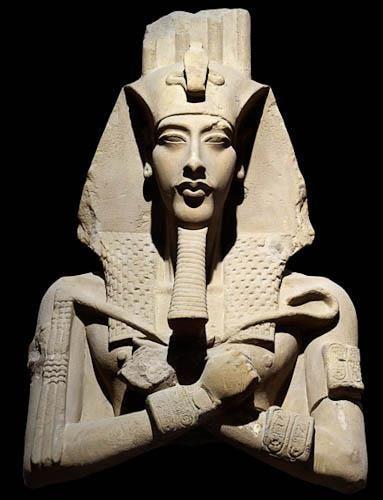

My diary
Circa: 1353 BC
Wonder of wonders, I am to marry Amenhotep 1V, who is to become the tenth Pharaoh of this dynasty. He is a far-sighted man who has great plans for our Empire and has wonderful ideas for temple buildings and for our art. He wants us to create a new dynasty to be a new step for Egypt in peace – away from wars.
Circa: 1352 BC
We have our first child, a daughter to be named Meritaten, meaning ‘beloved of our sun god, Aten’. The priests seem a little unsure of this name, but I think it’s lovely and Amenhotep feels a particular bond to this god. When he stands to the people, he has me stand by him. I feel so proud. The gods are good to us.
Akhenaten early in reign, c. 1353 BC
Circa: 1348 BC
The Pharaoh resents the power of the priests in Thebes who have grown rich as a military priesthood. Through the many gods that control our lives, they have controlled life in Egypt and throughout the Empire. He wants to mark a change by sweeping away these gods to just one: ‘Aten’ and changing his name to Akhenaten.
He has built a new city with this name, celebrating
a new artistic style away from that of the priests. In
his childhood he learned so much from the
craftsmen serving Ptah, the god of craftsmen.
I fear for the retribution of the priests as their power
has been taken and is now rests with my husband.
But I see a new future for Egypt, of love and beauty.
It is us two against the world.
Archaeological depiction of the City of Akhenaten

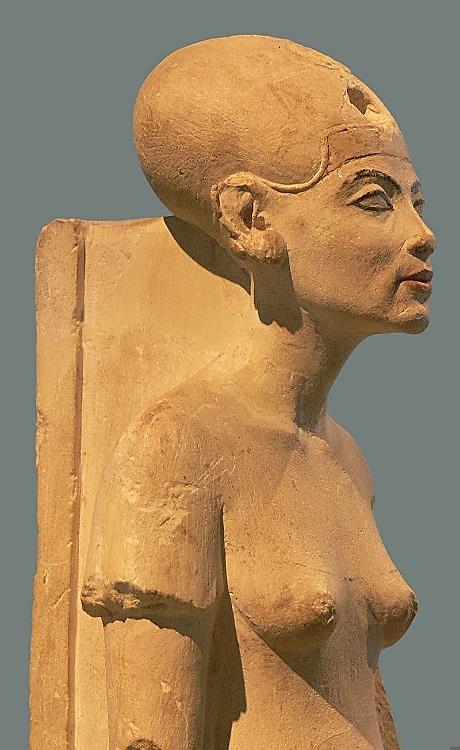
Circa: 1347 BC
We have decorated the new temples with our new artistic style here and in other cities - so different from the old, traditional, religious portrayals. We have portrayed ourselves with slender figures and
exaggerated bodies, which seem to mark this very different age.
In these inscriptions he shows we are a family like any other. We now have two daughters.
Circa: 1342 BC Akhenaten and Nefertiti with their two daughters Moving to this new city has made Akhenaten so much happier and he is planning great celebrations for next year. Our sixth daughter has been born.
Circa: 1341 BC
Akhenaten is making me officially co-regent with equal status to him – the Pharaoh.
I am to be titled Queen of Egypt and will be at the centre of these great celebrations.
People are coming from every corner of our Empire with the most magnificent gifts.
All to celebrate the completion of our new city and our victories in military campaigns. Our status and future can never have been higher.
Circa: 1340 BC
Great terror, our many guests brought the plague to our lands. I fear for our people.
I am so lost, three of our daughters have died in the plague and the whole city has suffered great losses. Our families can never recover from such terrible deaths.
We are in a great mourning and stepping back from many of our royal duties, although we are still building temples to our God Aten, throughout our lands.
Bust of Nefertiti, c. 1350 BC, Neues Museum, Berlin.
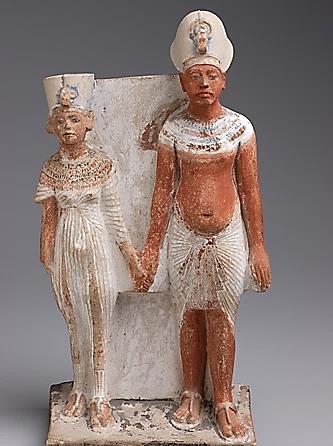

Circa: 1336 BC
My husband has died and with this great loss, I fear for our family. The vultures that are the Priests are already circling from Thebes, but as Queen of Egypt I can take on the role of Pharaoh. But I will have to reinstate the status of the Priests and bring back all the ancient Gods, through which they originally found their power. I feel a traitor to Akhenaten for all that he did to free Egypt from these traditional Gods and the priests, but our family has already suffered much.
I shall raise our young nephew Tutankhaten to these traditional gods, so that he may take up his role as Pharaoh and perhaps rule alongside me in his early years. This will hopefully secure his position. In the same way I must adopt the new title of Neferneferuaten, so keeping my faith to our God ‘Aten’.
Tutankhamun, Mummy, 1323 BC
Nefertiti was to reign for possibly a further four years, before her death aged around 40. (8) The reign of her husband Akhenaten was reviled by the Egyptian priesthood and resented by the people as controlling access to their traditional gods. He was so committed to take control in his new capital, that uniquely he may have used teams of children in its construction, literally working them to death. Within a few years his legacy was obliterated, his capital left to fall into ruins and this ‘heretic’ King was even taken from some lists of Egyptian Kings. The God of creation, Amun was restored to his primary status and Tutankhaten changed his name to this God as Tutankhamun. It has been speculated that he was Akhenaten’s son by his father’s sister, a not uncommon situation at that time. (9)
Nefertiti’s unique regency with husband and wife equally sharing the reign and introducing a single national God, was confined to history and remains unique to this day, 3,000 years later.
It is Nefertiti – which means: ‘The Beautiful Woman has come’ – who has kept their story alive over the centuries as her life and legacy are told.
Sources of Information:
(1) https://www.youtube.com/watch?v=JwXOj6okmuY Diego Rivera works (2) https://www.imdb.com/video/vi871341593 Film ‘Frida’ trailer (3) https://en.wikipedia.org/wiki/Cecilia_Gallerani
(4) https://eu.usatoday.com/in-depth/life/women-of-the-century/2020/08/12/19th-amendment-ruby-bridges-now-teaches-
kids-racism-and-peace/5555100002/
(5) https://en.wikipedia.org/wiki/Dora_Maar
(6) https://mymodernmet.com/early-20th-century-tokyo-film/ Rare Archival Film of Early 20th Century Tokyo
(7) https://www.youtube.com/watch?v=XtnRt-AZPUA Anime film excerpts: ‘Night on the Galactic Railroad’
(8) https://en.wikipedia.org/wiki/Nefertiti
(9) https://en.wikipedia.org/wiki/Akhenaten
Books in this Series
Book 1 Egypt - Greece - Rome Empires come & Empires go 2 The Renaissance in Italy Rulers rule, Painters Create
3 The Four Princes War, Terror & Religion 4 Northern Europe Revolution & Evolution 5 The American Dream Depression to Optimism
6 The Modern World The ‘..isms’ of Art
7 Past Voices Stories behind the Art All free e-book downloads
https://www.artystories.org

‘Dream of a Sunday afternoon in Alameda Park’, Diego Rivera, 1946-47
The history of life and art across centuries of changing societies and changing cultures.
‘I think the concept for your work is both creative and engaging for young people.
The links between art, history, society are clear in the outline you provide and the opportunities to stimulate young people’s interest and imagination are evident’.
Sir Nicholas Serota,
Chairman, Arts Council, England

















































